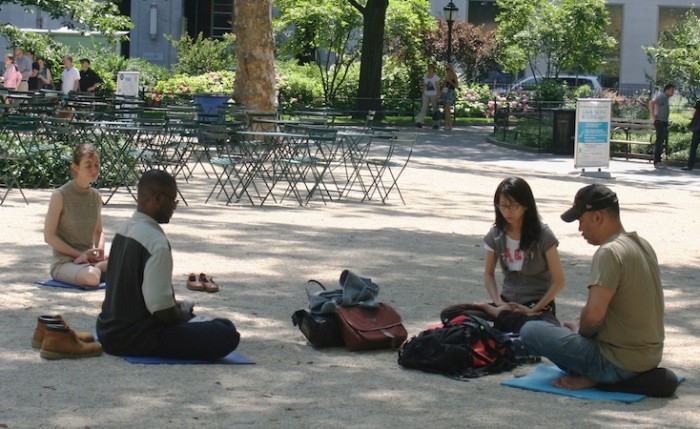And why I choose not to get a graduate degree.
My close friends from college have all earned prestigious graduate degrees. Me? Not so much. My ethnic parents have tried to push me in that direction but to no avail.
It’s not because I don’t like learning. In fact, it’s precisely because I love learning for its own sake and care little for accumulating accolades or corporate titles that I’ve chosen not to go back to school.
For all of us who are naturally curious and just wish to learn in a self-directed, affordable way over the course of our lives, the current system of higher education fails us.
For 60% of the American population, formal education ends when we’re teenagers. I’m left wondering—Why is this the case? Why can’t learning be a lifetime proposition?
Perhaps it’s not that the majority of people do not like learning, but that the current higher education system itself is flawed and does not suit our needs.
I propose we look to another model—the tradition of yoga—as a potential blueprint for the future. Why yoga? Because the yoga model is successful and growing (yoga has grown by 30% in only the past four years), and a good researcher looks first for what is thriving in our society.
So I invite you to release your current view of the world and embark on a thought experiment with me. Let’s imagine what higher education could be if it looked more like yoga…
We begin at the foundation.
The underlying premise of the entire yogic tradition is that each one of us is an eternal student. We learn from the moment we are born until the moment we take our last breath. Every yoga teacher is first and foremost a student.
For most Americans, this isn’t the reality. Learning will end at 18 years old. For 40% of us, learning will continue for another two to four years. Only 10% of us will earn a graduate or professional degree. Regardless of which category we fall into, this leaves about 40 to 60 years of our life with no formal education.
What if, like the yoga model, we were permanent students, forever enrolled in school? We continually receive various degrees over the course of our lives in any topic that interests us. Now imagine that professors are forever taking courses from other professors all over the country, cross-pollinating and combining what they’ve learned in new ways, and constantly creating new courses.
Sounds pretty cool, right? Now, let’s think about how we become students in the first place.
In yoga, we are all born into this world as students. We simply need to find a teacher and commit to the practice. Costs for classes vary, but many programs exist to make yoga affordable.
Now really ponder this for a moment: in our current higher education system, we cannot be a student unless an admissions committee tells us we can be a student. Our society has turned learning into a competitive sport, and for the most part, it revolves around rejection.
At many prestigious institutions over 90% of applicants are rejected (Standford proudly tops the list having rejected 94.3% of applicants in 2013). If accepted, we are then required to pay an exorbitant fee, which will leave us deeply in debt for the next few decades.
All of this, just to learn.
Now enter my visionary world. We’re all students by birthright. Everyone is accepted to any school they want to go to. No doors will shut in your face. No need to compete with anyone else for a spot.
All schools and courses will be affordable with little to no debt (think what Germany has done). You attend the school that is the right fit for you, not the only one you can afford or the only one that accepted you. Crazy talk, right?
Ok, so how does learning happen in my dream world?
In yoga, it’s very simple: we learn it by doing it.
Conversely, universities leave little room for experiencing concepts firsthand and drawing our own conclusions. The popular yogic mantra of “discarding anything that doesn’t serve you” could not be more foreign in the higher education arena. It’s more like “discard your own thoughts in favor of what the professor is testing you on.”
What if we allowed more freedom for interpretation, self-directed learning, and creating our own degrees? Some progressive universities have tiptoed into this arena, but it should be the norm, not the exception.
Let’s move onto more practical matters and think about how learning fits into our daily lives.
In yoga, we the students decide on our preferred location and time, what styles of yoga we want to learn, and the teachers we want to learn from. We have the freedom to change our yoga style, our learning environment and our teachers freely and easily as circumstances evolve.
In university world, we only take classes from a single school that we are enrolled in. There is a long list of required classes in order to graduate with a particular degree. In my experience, for all the money that was paid, I still never got the professors, times, or classes that I most preferred.
Now imagine, instead of being accepted into a particular school, you simply were a student of the entire education system. Open doors. You could take any course from any school. It’s like becoming a member of Gold’s Gym—you have access to any gym, teacher and class in the country.
Next, let’s examine the role of the professor.
In yoga, the teacher is there to simply serve as our guide. He or she offers suggestions and tailors the practice to fit the students. Ultimately, the student decides what is best for them and their own bodies.
The current role of the professor is to interpret most of the material for us and determine what is worth discussing and what is worth evaluating us on.
But what if the professor was more like a yoga teacher? They were not there to give you all their pre-packaged answers, but rather to give you the tools for coming to your own conclusions.
So how does one become a professor in the first place?
In yoga, we take a teacher training. Most trainings will accept all students who complete the application and pay the tuition fee. There are no alumni legacies or standardized tests. The cost of the training is reasonable, average being $2,960, which thankfully won’t put us in debt for the next 20 years.
Enter our university model. Let’s say we love poetry, and we have this burning desire to teach others all about the wonders of Emily Dickinson. To do this, we now have to get accepted into another program, spend tens of thousands of dollars for another degree and then get accepted as faculty by a university. How many people could have become wonderful professors, but chose not to because of all the barriers?
Some may say it should remain difficult to become a professor so that the standards remain high. I understand this argument, but who determines these standards? It’s not the students. And does this mean all professors are wonderful teachers?
If we followed the yoga teacher model instead, almost anyone could become a teacher, but eventually the cream would rise to the top. The best teachers are the ones with popular books, blogs and classes because their teachings are the most insightful and relevant as determined by the students.
Overall, it’s better to be inclusive and allow market forces to weed out the poor professors, rather than make it almost impossible to become a professor in the first place. Do the dangers of allowing more people to teach justify the barriers? In the university model, you’re running the risk of losing greatness and innovation by creating impossibly high barriers to entry.
Ideally, it would be that students have the freedom to choose the professor that motivates and inspires them. They could leave at any time without consequences. Students will naturally gravitate to the best professors. The best professors will become more popular and their teachings will spread, leaving behind ineffective professors.
Lastly, how do we teach others to become professors and create courses?
In yoga, if we want to train others to become teachers, we start a school. We can choose to register with Yoga Alliance; however, anyone can teach yoga or train others with no certification at all.
There is no governing body that determines what is “good” yoga and what isn’t, and nobody decides what constitutes a legitimate yoga style. Anyone is free to create his or her own yoga style or philosophy.
In university world, nobody teaches you how to be a professor. It’s assumed that if you’ve attained a PhD in a subject, then you must know how to present the material in a way that will inspire and motivate others to learn it. Furthermore, it will be years before you can develop your own course.
In dream world, you would be trained on how to teach before becoming a professor, and you could formulate new courses at any time. Your course may only get two students, but you would still have the opportunity to go for it, like any other business idea.
Let’s imagine that your new “Buddhism in the Modern World” course becomes very popular. Your students come to you wanting to teach the course at other locations. Presto. You design a training and begin teaching others how to teach your class. The most popular and relevant information spreads.
So what does the yoga model teach us about higher education?
In short, if we want more people to access higher education, it really boils down to two factors: increasing personal freedoms and reducing barriers.
Yoga is a demand-driven model and barriers to entry are low. Students “vote” every day with their attendance and their money. We all have the freedom to choose how, when, where, and from whom we learn yoga. Then we choose how we share and teach what we have learned.
On the other hand, the university model is supply-driven. The supply is packaged in a very specific way, and we can “take it or leave it.” Barriers to entry are high and freedoms are limited.
I’m not saying that the yoga model is perfect (I could write a whole another article on what I would change), nor am I saying that the imaginary world I painted for higher education is capable of existing in reality. But I do believe strongly that universities could learn a lot from how people practice and teach yoga because shouldn’t we all learn from successful models?
If the widespread adoption of the Internet has taught us anything, it’s that barriers to information are harmful to society (think China). By extension, it makes sense that we should eliminate barriers that prevent people from learning.
So if that’s the case, why do we make it so difficult for adults to continue learning or for adults to become professors? How does that benefit us? Shouldn’t we be making it easier for people to become more educated; not keeping it so expensive, rigid and elitist that only 40% of our population accesses it? What innovative ideas are we missing out on because of societal barriers?
The time has come for the model to be updated, and I’m ready for Higher Education 2.0 to hit the marketplace. Who’s with me?
Please comment and add to the conversation. Only by thinking creatively and sharing our ideas with one another can we begin to re-engineer how higher education is viewed and implemented in our world.
Love elephant and want to go steady?
Sign up for our (curated) daily and weekly newsletters!
Author: Janice Pappas
Editor: Travis May
Image: Wikipedia







Read 0 comments and reply